Incidence and Characterization of Facial Lacerations in Emergency Departments in the United States
Abstract
Introduction
Methods
Data Source and Study Design
Study Population
Outcomes
Study Variables
Statistical Analysis
Results
Patient Characteristics
Hospital Characteristics
Emergency Department Procedures
Discussion
Conclusion
Funding
Conflicts of Interest
Appendix A
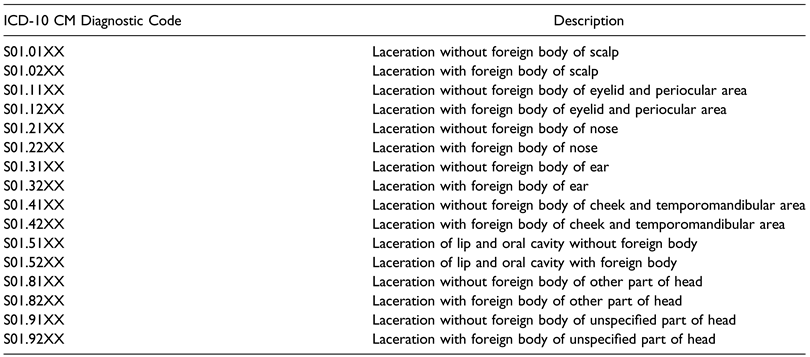 |
References
- Singer, A.J.; Thode, H.C.; Hollander, J.E. National trends in ED lacerations between 1992 and 2002. Am J Emerg Med. 2006, 24, 183–188. [Google Scholar] [CrossRef]
- Loder, R.T.; Momper, L. Demographics and fracture patterns of patients presenting to US emergency departments for intimate partner violence. JAAOS Glob Res Rev. 2020, 4, e20. [Google Scholar] [CrossRef]
- Laski, R.; Ziccardi, V.B.; Broder, H.L.; Janal, M. Facial trauma: A recurrent disease? The potential role of disease prevention. J Oral Maxillofac Surg. 2004, 62, 685–688. [Google Scholar] [CrossRef] [PubMed]
- Roccia, F.; Bianchi, F.A.; Zavattero, E.; Baietto, F.; Boffano, P. Etiology and patterns of facial lacerations and their possible association with underlying maxillofacial fractures. J Craniofac Surg. 2011, 22, e19–e23. [Google Scholar] [CrossRef] [PubMed]
- Hwang, K.; Huan, F.; Hwang, P.J.; Sohn, I.A. Facial lacerations in children. J Craniofac Surg. 2013, 24, 671–675. [Google Scholar] [CrossRef] [PubMed]
- Kim, E.J.; Bustos, V.P.; Lee, B.T. Sources of facial injury across age groups: A Nationwide overview using the national electronic injury surveillance system database. J Craniofac Surg. 2023, 34, 1927–1930. [Google Scholar] [CrossRef]
- Sethi, R.K.V.; Kozin, E.D.; Fagenholz, P.J.; Lee, D.J.; Shrime, M.G.; Gray, S.T. Epidemiological survey of head and neck injuries and trauma in the United States. Otolaryngol Neck Surg. 2014, 151, 776–784. [Google Scholar] [CrossRef]
- Nawar, E.W.; Niska, R.W.; Xu, J. National hospital ambulatory medical care survey: 2005 emergency department summary. Adv Data 2007, 1–32. [Google Scholar]
- Hollander, J.E.; Singer, A.J.; Valentine, S.M.; Shofer, F.S. Risk factors for infection in patients with traumatic lacerations. Acad Emerg Med. 2001, 8, 716–720. [Google Scholar] [CrossRef]
- Haughey, R.E.; Lammers, R.L.; Wagner, D.K. Use of antibiotics in the initial management of soft tissue hand wounds. Ann Emerg Med. 1981, 10, 187–192. [Google Scholar] [CrossRef]
- Patel, P.R.; Miller, M.A. Postcare recommendations for emergency department wounds. Emerg Med Clin. 2007, 25, 147–158. [Google Scholar] [CrossRef] [PubMed]
- Quinn, J.; Wells, G.; Sutcliffe, T.; et al. A randomized trial comparing octylcyanoacrylate tissue adhesive and sutures in the management of lacerations. JAMA. 1997, 277, 1527–1530. [Google Scholar] [CrossRef]
- Healthcare Cost and Utilization Project (HCUP). HCUP National Emergency DepartmentRockville Sample. MDNEDS; Agency for Healthcare Research and Quality: Rockville, MD, USA, 2022. [Google Scholar]
- Lee, J.H.; Jeon, M.S.; Lee, D.L.; Shin, H.K.; Seul, J.H. Analysis of patients with facial lacerations repaired in the emergency room of a provincial hospital. Arch Plast Surg. 2015, 42, 34–39. [Google Scholar] [CrossRef] [PubMed]
- Lo, S.; Aslam, N. Mechanisms and pattern of facial lacerations in the Accident Department. Int J Clin Pract. 2004, 59, 333–335. [Google Scholar] [CrossRef] [PubMed]
- Eaton, D.K.; Kann, L.; Kinchen, S.; et al. Youth risk behavior surveillance–United States, 2007. Morb Mortal Wkly Rep Surveill Summ Wash DC. 2008, 57, 1–131. [Google Scholar]
- Shaikh, Z.S.; Worrall, S.F. Epidemiology of facial trauma in a sample of patients aged 1–18 years. Injury. 2002, 33, 669–671. [Google Scholar] [CrossRef]
- Khan, T.U.; Rahat, S.; Khan, Z.A.; Shahid, L.; Banouri, S.S.; Muhammad, N. Etiology and pattern of maxillofacial trauma. PLoS One. 2022, 17, e0275515. [Google Scholar] [CrossRef]
- Bernstein, S.L.; Aronsky, D.; Duseja, R.; et al. The effect of emergency department crowding on clinically oriented outcomes. Acad Emerg Med. 2009, 16, 1–10. [Google Scholar] [CrossRef]
- Key, S.J.; Thomas, D.W.; Shepherd, J.P. The management of soft tissue facial wounds. Br J Oral Maxillofac Surg. 1995, 33, 76–85. [Google Scholar] [CrossRef]
- Zbar, R.I.S.; Monico, E.; Calise, A. Consultation for simple laceration repair when on-call in the emergency department: Potential quagmire. Plast Reconstr Surg - Glob Open. 2017, 5, e1428. [Google Scholar] [CrossRef]
- Cullen, S.; Wrafter, P.F.; Jones, D.; et al. Plastic surgery procedure unit: A streamlined care model for minor and intermediate procedures: A cost-benefit analysis. J Plast Reconstr Aesthetic Surg. 2021, 74, 192–198. [Google Scholar] [CrossRef]
- Zehtabchi, S. The role of antibiotic prophylaxis for prevention of infection in patients with simple hand lacerations. Ann Emerg Med. 2007, 49, 682–689.e1. [Google Scholar] [CrossRef] [PubMed]

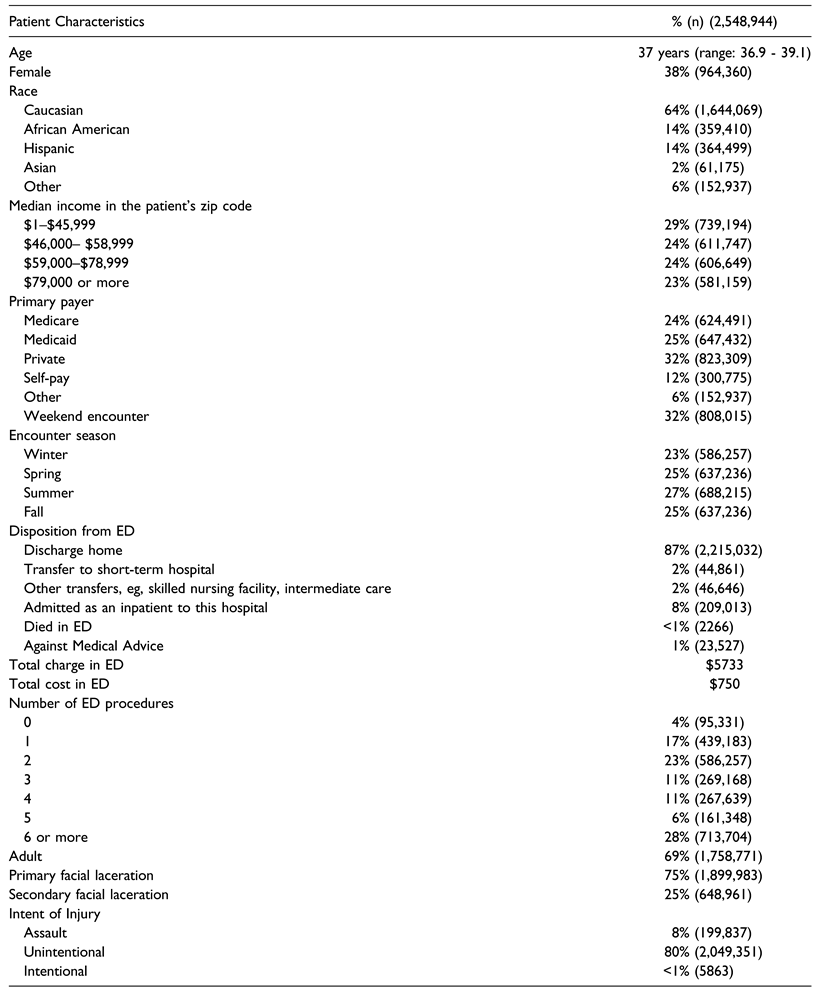 |
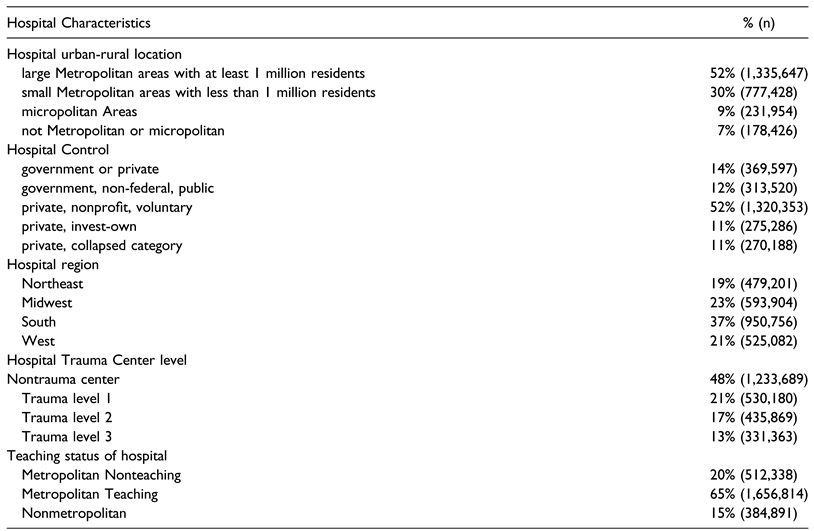 |
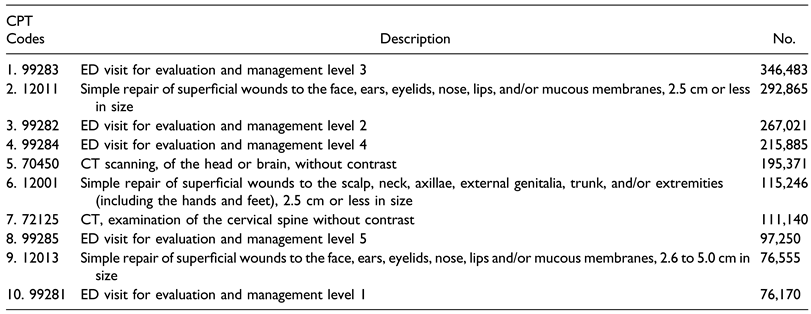 |
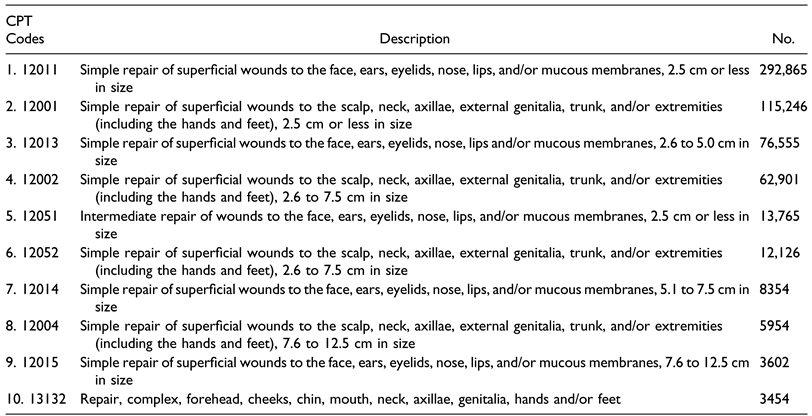 |
© 2024 by the authors. The Author(s) 2024.
Share and Cite
Peluso, H.; Vega, K.; Araya, S.; Talemal, L.; Moss, C.; Siegel, J.; Walchak, A. Incidence and Characterization of Facial Lacerations in Emergency Departments in the United States. Craniomaxillofac. Trauma Reconstr. 2024, 17, 74. https://doi.org/10.1177/19433875241257572
Peluso H, Vega K, Araya S, Talemal L, Moss C, Siegel J, Walchak A. Incidence and Characterization of Facial Lacerations in Emergency Departments in the United States. Craniomaxillofacial Trauma & Reconstruction. 2024; 17(4):74. https://doi.org/10.1177/19433875241257572
Chicago/Turabian StylePeluso, Heather, Kevin Vega, Sthefano Araya, Lindsay Talemal, Civanni Moss, Jake Siegel, and Adam Walchak. 2024. "Incidence and Characterization of Facial Lacerations in Emergency Departments in the United States" Craniomaxillofacial Trauma & Reconstruction 17, no. 4: 74. https://doi.org/10.1177/19433875241257572
APA StylePeluso, H., Vega, K., Araya, S., Talemal, L., Moss, C., Siegel, J., & Walchak, A. (2024). Incidence and Characterization of Facial Lacerations in Emergency Departments in the United States. Craniomaxillofacial Trauma & Reconstruction, 17(4), 74. https://doi.org/10.1177/19433875241257572




